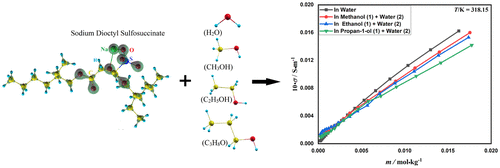当前位置:
X-MOL 学术
›
J. Chem. Eng. Data
›
论文详情
Our official English website, www.x-mol.net, welcomes your
feedback! (Note: you will need to create a separate account there.)
Conductance Study of Aerosol-OT in Binary Mixed Solvents of Short-Chain Alcohol–Water Systems at Various Temperatures
Journal of Chemical & Engineering Data ( IF 2.0 ) Pub Date : 2020-11-11 , DOI: 10.1021/acs.jced.0c00126 Nabin Basnet 1, 2 , Sushila Prasai 1 , Hector Dominguez 3 , Marlene Ríos-López 3 , Rajendra Adhikari 4 , Madhav Prasad Ghimire 5, 6, 7 , Ajaya Bhattarai 8
Journal of Chemical & Engineering Data ( IF 2.0 ) Pub Date : 2020-11-11 , DOI: 10.1021/acs.jced.0c00126 Nabin Basnet 1, 2 , Sushila Prasai 1 , Hector Dominguez 3 , Marlene Ríos-López 3 , Rajendra Adhikari 4 , Madhav Prasad Ghimire 5, 6, 7 , Ajaya Bhattarai 8
Affiliation

|
The conductivity of the anionic surfactant sodium bis(2-ethylhexyl) sulfosuccinate (AOT) is measured in binary mixed solvent media containing 0.000, 0.080, 0.252, and 0.440 mass fractions of methanol, ethanol, and propan-1-ol at temperatures of 298.15, 308.15, and 318.15 K, separately, within the concentration range of ∼1.89 × 10–2 to 2.20 × 10–4 mol·kg–1. The addition of alcohols separately in water decreases the dielectric constant and solvophobic effect and increases the viscosity of the mixed media in the entire range of investigations. The dissociation of AOT gives rise to a simple cationic sodium ion and a bulky anionic dioctyl sulfosuccinate (DS) ion composed of a hydrophobic tail and a polar head. The conductivity was found to be positively correlated with the dielectric constant, solvophobic effect, and temperature, while it was found to decrease with the increase in viscosity for the given mixed medium. To support the experimental measurement, we performed molecular dynamics (MD) simulations for different mixed media, wherein reasonable agreement was found for the electrical conductivity of AOT. Furthermore, density functional theory (DFT) calculations were performed for the pristine DS and AOT to study their electronic properties in the absence of solutions. It turns out that the electronic conductivity arises in the AOT mixture, supporting the findings of experimental and MD simulations.
中文翻译:

短链醇水体系二元混合溶剂中不同温度下气溶胶-OT的电导研究
阴离子表面活性剂双(2-乙基己基)磺基琥珀酸钠(AOT)的电导率在298.15的温度下,以0.000、0.080、0.252和0.440质量分数的甲醇,乙醇和丙-1-醇的二元混合溶剂介质进行测量。 ,308.15和318.15 K,分别在〜1.89×10 –2至2.20×10 –4 mol·kg –1的浓度范围内。在整个研究范围内,在水中分别添加醇会降低介电常数和疏溶剂效应,并增加混合介质的粘度。AOT的解离产生简单的阳离子钠离子和由疏水尾和极性头组成的庞大的阴离子二辛基磺基琥珀酸酯(DS)离子。发现电导率与介电常数,疏溶剂效应和温度呈正相关,而对于给定的混合介质,电导率随粘度的增加而降低。为了支持实验测量,我们对不同的混合介质进行了分子动力学(MD)模拟,其中发现AOT的电导率合理。此外,对原始DS和AOT进行密度泛函理论(DFT)计算,以研究在不存在溶液的情况下的电子性能。事实证明,在AOT混合物中会产生电子导电性,从而支持了实验和MD模拟的发现。
更新日期:2021-01-14
中文翻译:

短链醇水体系二元混合溶剂中不同温度下气溶胶-OT的电导研究
阴离子表面活性剂双(2-乙基己基)磺基琥珀酸钠(AOT)的电导率在298.15的温度下,以0.000、0.080、0.252和0.440质量分数的甲醇,乙醇和丙-1-醇的二元混合溶剂介质进行测量。 ,308.15和318.15 K,分别在〜1.89×10 –2至2.20×10 –4 mol·kg –1的浓度范围内。在整个研究范围内,在水中分别添加醇会降低介电常数和疏溶剂效应,并增加混合介质的粘度。AOT的解离产生简单的阳离子钠离子和由疏水尾和极性头组成的庞大的阴离子二辛基磺基琥珀酸酯(DS)离子。发现电导率与介电常数,疏溶剂效应和温度呈正相关,而对于给定的混合介质,电导率随粘度的增加而降低。为了支持实验测量,我们对不同的混合介质进行了分子动力学(MD)模拟,其中发现AOT的电导率合理。此外,对原始DS和AOT进行密度泛函理论(DFT)计算,以研究在不存在溶液的情况下的电子性能。事实证明,在AOT混合物中会产生电子导电性,从而支持了实验和MD模拟的发现。











































 京公网安备 11010802027423号
京公网安备 11010802027423号